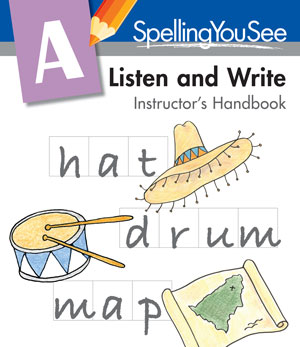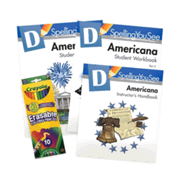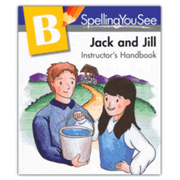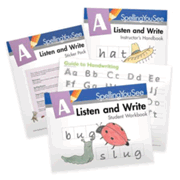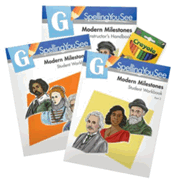Forget weekly spelling lists and spelling tests! Spelling You See (SYS), instead, uses a developmental approach to spelling that is quite different from what we are used to in most spelling programs. Rather than grade-level designations, the series identifies courses with letters A through G.
- Level A Listen and Write
- Level B Jack and Jill
- Level C Wild Tales
- Level D Americana
- Level E American Spirit
- Level F Ancient Achievements
- Level G Modern Milestones
You start your child at the developmentally appropriate level. This is so critical that I'm including the link to their Readiness Guidelines. Check the guidelines before ordering.
Spelling You See was built on research showing that students progress through five developmental stages: preliterate, phonetic, skill development, word extension (syllables, prefixes, and suffixes), and derivational constancy (words related by derivation of origins that share common patterns). While Spelling You See builds on a phonetic base, it goes beyond that to help students also master irregular words and words borrowed from other languages that make spelling so challenging.
Continual review is a hallmark of this program. Consequently, children practice basic letter formation over and over in the younger levels, then practice writing very similar words and the same passages almost every day for a week. This way they develop a visual memory of words.
Students also learn to identify "chunks" (phonetic elements and consistent patterns) within words up through Level G, marking the chunks with colored pencils or highlighters. This process is referred to as "chunking." Students begin to color code the chunks in Level B, so sets of colored pencils are included with each course for Levels B and above. The program does not have children memorize spelling rules, but children learn the common patterns through continual exposure and chunking exercises.
SYS introduces a form of printing and uses it through all levels. The instructor's handbooks say that children should not do their copywork in cursive. They point out that "Copywork should be printed in order to develop visual memory. When students read, everything they see is in print, so they should use printing while learning to spell" (Frequently Asked Questions). There might be some truth to this, and I also realize that chunking is more difficult when students are writing with cursive forms. However, I think printing becomes quite cumbersome for writing lengthy passages. This shouldn't be an issue in SYS because writing activities are meant to be limited to ten minutes, whether or not the activity is completed.
SYS has daily lessons for 36 weeks for each level. Each week's lessons are labeled A through E for the five days of each week.
For each level, there are a student workbook and instructor's handbook. For all except Level A, the student workbook has two volumes, Part 1 and Part 2. Instructor's handbooks are relatively small books that offer teaching assistance that is most valuable at the first two levels. They also include answers keys and dictation material that is essential for each level. Answer keys include the color coding for the chunking.
Extra help, including videos explaining some aspects of the courses, are available on the Spelling You See website.
Level A Listen and Write
Level A begins with letter formation, concentrating on lowercase letters. The course includes a laminated "Guide to Handwriting" showing the proper directions for letter formation. The style is a simple manuscript that—unlike the ball-and-stick method—teaches students to form letters without lifting their pencil except for just a few letters. The program stresses the importance of children holding their pencils properly. The font for the letters a, l, and t includes a slight curve at the bottom. While this is unusual, there is nothing wrong about it, and it might facilitate the transition to cursive.
Children trace and write six letters per day for six weeks. They also begin to trace and copy words such as cat, dad, and gas—only short-a words for the first four weeks—in preparation for upcoming dictation activities that begin the fourth week.
Short-i words are introduced the fifth week, with words for the other short vowels gradually introduced later. In the seventh week, students begin to read words back to the teacher after dictation. Lessons for the first half of the course use only three-letter words, while four- and five-letter words are taught the second semester along with consonant blends (e.g., st), digraphs (e.g., ck), and double consonant endings (e.g., tall). Children write from 10 to 12 words each day from dictation.
Level A has only one worksheet per day, and each day's lesson should take only about ten minutes to complete. A child might not complete a page if it seems like too much work at that point. A sticker pack is included that can be used either for motivation or along with the suggested activities.
Once you are past the first few lessons and understand how the lessons are completed at each level, the instructor's handbook has only one or two paragraphs of instructions per lesson. Lesson preparation time is very minimal even for the first few lessons.
Level B Jack and Jill
Level B has two worksheets per day, so there are now two student workbooks, Part 1 and Part 2. Students will use colored pencils (or highlighters) along with a regular pencil to complete the worksheets. The laminated "Guide to Handwriting" is included.
As in Level A, students begin by tracing and copying letters and words. They quickly move on to dictation with short-vowel words.
Level B also incorporates well-known nursery rhymes into the lessons, using the same nursery rhyme every day for one week. The rhymes provide copywork practice, serve as simple narrative devices, help with vocabulary development, help students distinguish similar sounds, and provide an auditory component to the lessons. Students begin by copying parts of the rhyme each day, paying attention to capitalization and punctuation as well as spelling. By the end of Level B, students are expected to write an entire nursery rhyme from dictation.
Students learn "chunking"—the method used throughout the rest of the program. This is a method of marking particular letter patterns with specified colored pencils or highlighters. Instructions are given within the instructor's handbook, but they are also conveniently included at the beginning of each day's lesson. For example, for the second day of the ninth week, instructions at the top of the page tell the teacher how to present the nursery rhyme that day, then it introduces chunking with instructions about identifying "Bossy r" chunks and highlighting them with a purple colored pencil or highlighter. Through the rest of Level B and beyond, students become familiar with both vowel and consonant chunks as well as silent letters, endings such as es and ful, as well as "overlapping chunks" where the final y is changed before adding an ending.
"No rule days" appear on the fourth day of each lesson in Part 2. These offer opportunities for drawing or creative writing that should be very relaxed.
Copywork and dictation exercises for Level B and above should always be kept to no more than 10 minutes. Counting the number of words written from dictation correctly within 10 minutes helps you to evaluate a student's progress. Students should continually improve their speed and accuracy.
Level C Wild Tales
Level C begins with a few nursery rhymes as in Level B then shifts to non-fiction passages about all sorts of living creatures from black bears and bats to seahorses and penguins. From the eighth week till the end of the course, lessons follow the same pattern each week. Students have chunking exercises every day, copywork the first three days, drawing or creative writing added on the fourth day, and dictation on the last day.
Level D Americana
Level D continues in the same fashion as Level C with students completing chunking exercises each day. The reading passages are now from American History and culture featuring topics such as Thomas Jefferson, the Liberty Bell, Rosa Parks, Paul Bunyan, and Levi Strauss.
For the first three days of each lesson, students copy parts of the passage and mark the chunks. On day four, they are given the passage through dictation, with the parent or teacher supplying assistance as needed. On the fifth day, they write the same passage from dictation but with help only for punctuation and capitalization. Each time, you should continue to limit the exercise to 10 minutes, even if students do not complete the entire passage.
Level E American Spirit
Level E uses reading passages that highlight American ingenuity and inventiveness along with other positive character traits through stories of Patrick Henry, Mary Hays, P.T. Barnum, Harry Houdini, President John F. Kennedy, and others. The lesson format for each week is the same as for Level D. While some passages in Level E appear to be more challenging than those in Level D, many seem to be on about the same level.
Level F Ancient Achievements
Level F shifts gears by putting more responsibility on the student. Instead of a parent reading the short stories to the student each day, the student now reads the stories to a parent. Stories are all drawn from ancient civilizations, highlighting particular achievements in art, inventions, exploration, and other areas. Students should also try to complete chunking exercises on their own. They continue with copywork and dictation as before. Each week's lesson spotlights an interesting fact or explanation about words and their components, with a goal of stimulating students' interest in word origins and phonetic elements.
Level G Modern Milestones
While Level G continues with copywork and dictation, chunking shifts to the identification of base words, prefixes, suffixes, and compound words. It uses stories of key people in modern history from the arenas of art, music, literature, and science. At this level, students complete their copywork in two days, and the third day is now used to complete a worksheet using plurals, suffixes, and prefixes.
Summary
While the program is unusual, the use of copywork and dictation reflect elements of both Charlotte Mason and Classical approaches that home educators have found to be very effective. Also, chunking bears some similarity to methods used in other programs that emphasize learning the phonograms, even though it is presented in a unique fashion in SYS. Some programs use only one or two of these three strategies but this combination of all three—chunking, copywork, and dictation—makes Spelling You See a promising option for helping children learn to spell. Free sample lessons for each level are available on the publisher's website.

